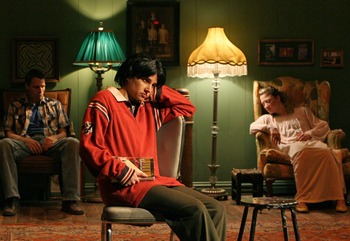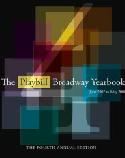SITE GUIDE
SEARCH
REVIEWS
REVIEW ARCHIVES
ADVERTISING AT CURTAINUP
FEATURES
NEWS
Etcetera and
Short Term Listings
LISTINGS
Broadway
Off-Broadway
NYC Restaurants
BOOKS and CDs
OTHER PLACES
Berkshires
London
California
New Jersey
DC
Philadelphia
Elsewhere
QUOTES
TKTS
PLAYWRIGHTS' ALBUMS
LETTERS TO EDITOR
FILM
LINKS
MISCELLANEOUS
Free Updates
Masthead
A CurtainUp Review
The Sound and the Fury (April Seventh, 1928)
by Les
Gutman
|
It is a tale Told by an idiot, full of sound and fury Signifying nothing. ---Macbeth, Act V, scene v |
 B. Williams, S. Sokol and A. McNamara
(Photo: Joan Marcus) |
On the heels of its production of Gatz, an unabridged staging of The Great Gatsby which has been presented all over the world but (for legal reasons) not in New York, Elevator Repair Service brings us a stage version of the first part of Faulkner's confounding stream of consciousness novel, The Sound and the Fury. In this part, which ERS renders virtually verbatim, the Compson family saga is told through the eyes of the "idiot" son, Benjamin a/k/a Benjy f/k/a Maury. In the book, he moans but does not speak. Save a few bits of narrative very early on, the character is mute onstage.
If this sounds like more of a staging challenge than one might sanely want to undertake, it is. Which is of course why it likely appealed to the seemingly fearless Elevator people. The book is difficult to follow, since it is non-linear, and Faulkner's effort to keep the forward and backward movement of time organized by means of italics is both unsuccessful and incomplete. It's one of those books that calls for a notepad while reading, especially if (as was the case for me) it was assigned reading in an English class.
ERS has supplied a useful family tree in the program to obviate the need for taking notes, and opens the show with even more helpful slide projections sorting out the characters. To avoid anything approaching the presentation of a Cliff Notes version of the book, and presumably to maintain some semblence of the book's dissociative leanings, ERS also has multiple actors portraying the same characters at different times or, in some cases, at the same time. Passing around a paperback copy of the book, the actors also take turns reading the book to us. Oftentimes (but not always), an actor portraying the character delivers the dialogue, with the reader supplying the "he said/she said" from the text. At other times, the character appends the explanation to the dialogue as it is recited. Similarly, in some cases, characters are costumed in keeping with the role (sometimes swapping costume elements as they swap characters), while at other times they do not. There are also occasional dance routines, performed in what those familiar with ERS would call its signature style.
By now, you may be thoroughly convinced that I have described a theatrical monstrosity. And for some, including the spattering of people who couldn't make it even to the intermission at the performance I attended without noisily departing, this may be the case. But for those many who remained through the two and a half surprisingly tedium-free hours, the show managed to signify something. Just what that is remains a bit of an enigma, and for the audience to engage it at all requires something approaching an act of surrender. I hasten to add that the same can certainly be said of the book as well, so if nothing else, the show remains fiercely, bizarrely and remarkably loyal to its source.
The cast as a whole is clearly committed to this undertaking, and one gets the feeling that directing it demanded that John Collins summon skills as a referee as much as those of a conventional director. In a cast of twelve, where the actors portray 27 characters in 56 formulations, it is nearly impossible to discuss or even describe the performances. I will single out only one, Susie Sokol who, for most of the play portrays Benjy (at some points, Aaron Landsman plays the character), using her face and body to convey one of the more believable characters you will likely experience onstage.
The show's design elements, not surprisingly, are also committed to the discord. The set is so painfully realistic that it seems like a colorized version of a deteriorating sepia photograph, yet no effort is made to explain away the intrusion into this interior of two of Benjy's particular fascinations, golf and fire; the former is "played through" the parlor, while the latter is most often represented by a video fireplace contained behind the door of an old piece of furniture that's rolled about. Some of the costumes are of the period, though they are often mixed with others that clearly are not. Sound and light sometimes appear as pathmarkers through the story, while at other times they seem to be functions of Benjy's unmarked mind.
In the end, I suppose we have to decide if ERS's trek through Faulkner's words adds anything to them. The fair answer is, I suspect, that it depends. I didn't feel worse for the experience, but I avoid wondering if I would have been equally or better served by having someone with a mellifluous voice sitting on an empty stage reading the text to me.
|
The Sound and the Fury (April Seventh, 1928)
by Elevator Repair Service, based on Part I of William Faulkner's novelDirected by John Collins with Mike Iveson, Vin Knight, Aaron Landsman, April Matthis, Annie McNamara, Randolph Curtis Rand, Greig Sargeant, Kate Scelsa, Kaneza Schaal, Susie Sokol, Tory Vazquez and Ben Williams Set Design: David Zinn Costume Design: Colleen Werthmann Lighting Design: Mark Barton Sound Design: Matt Tierney Dance Director: Katherine Profeta Running time: 2 hours, 30 minutes with 1 intermission New York Theatre Workshop, 79 East 4th Street (Bowery/E2nd Av) Telephone (212) 239-6200 Opening April 29, 2008, closes May 18, 2008 TUES @7, WED - SAT @8, SUN @2 and 7 (no performance 4/30, extra performance 5/3@3; $55 ($20 for all on Sundays, and for students with ID at any performance; $32 for seniors ages 65+ with ID) Reviewed by Les Gutman based on 4/27/08 performance |
|
REVIEW FEEDBACK Highlight one of the responses below and click "copy" or"CTRL+C"
Paste the highlighted text into the subject line (CTRL+ V): Feel free to add detailed comments in the body of the email. |
Try onlineseats.com for great seats to
Wicked
Jersey Boys
The Little Mermaid
Lion King
Shrek The Musical

Leonard Maltin's 2008 Movie Guide

Playbill 2007-08 Yearbook


Wicked
Jersey Boys
The Little Mermaid
Lion King
Shrek The Musical

Leonard Maltin's 2008 Movie Guide

Playbill 2007-08 Yearbook


